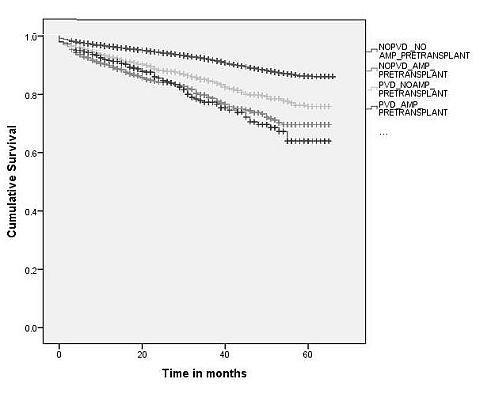Impact of Pre-Transplant Amputation on Renal Allograft Outcomes
SUNY Downstate Medical Center, Brooklyn, NY
Department of Surgery, Uniformed Services University of Health Sciences, Bethesda
Meeting: 2013 American Transplant Congress
Abstract number: C1184
Introduction: United States Renal Data System (USRDS) was used to assess renal allograft outcomes in patients with pre- transplant amputation (AMP).
Methods: We used an incident cohort of patients who underwent renal transplantation between June 2004, and September 2009.We defined peripheral vascular disease (PVD) as symptomatic PVD at the time of wait listing. Pre-transplant amputations data was obtained using Medicare claim forms. Co-morbid conditions were diabetes mellitus, ischemic heart disease, cerebrovascular disease and smoking. Chi square was used for statistical associations. Kaplan Meir survival curves were plotted to assess allograft survival.
Results: 85873 patients with renal transplant were identified .Out of these, 1410 (1.6%) patients had AMP. Prevalence of diabetes was higher in patients with AMP vs. no AMP (88% vs. 28.%) as was the prevalence of coronary artery disease (9.9% vs. 4.9%). The two groups did not differ significantly in smoking history and incidence of CVA. Mean allograft survival was 52.4 +- 0.64 months in patients with AMP vs. 60.71± 0.06 months without pre- transplant amputation (p=0.0001). Mortality was higher in patients with AMP vs. those who did not have AMP (19.4%vs 7.2%) p=0.0001. Mean allograft survival was 60.89+-0.62 months in those with no PVD and no AMP; 52.6 +-0.77 months in those with no PVD but had AMP; 55.8 +-0.42 months in those with PVD but no AMP and 52.0+-1.2 months in those with PVD and AMP.

Conclusions: Patients with AMP have inferior allograft and patient survival vs. those without AMP. We advise that patients with PVD and AMP should be counseled for risks and worked up rigorously for cardio-vascular conditions and correction of diabetes to reduce mortality.
To cite this abstract in AMA style:
Brar A, Jindal R, Mondal Z, Tedla F, Sumrani N, John D, Salifu M. Impact of Pre-Transplant Amputation on Renal Allograft Outcomes [abstract]. Am J Transplant. 2013; 13 (suppl 5). https://atcmeetingabstracts.com/abstract/impact-of-pre-transplant-amputation-on-renal-allograft-outcomes/. Accessed December 14, 2025.« Back to 2013 American Transplant Congress
